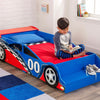5 Activities That Help Communication Skills for Kids

Communication milestones are some of the most fun – first words, first sentences, and all the adorably silly ways toddlers describe things. Fortunately, we don’t have to get fancy to encourage communication skills in our kids – one of the best things we can do is to talk with them as much as possible, using correct language and rich vocabulary. But adding in a few communication-building activities can be a fun way to challenge kids’ language skills and expose them to a wider range of vocabulary. Here’s a few simple activities to help your kids become confident, well-spoken communicators.
Reading
We know – this one is probably so obvious we could just skip it, but reading with your kids truly is one of the best things you can do to help them develop language and communication skills. Books not only help them develop a large vocabulary – kids will also intuitively pick up on sentence structure and grammatical rules, especially as you read some of the same books over and over.
Even story books without words can be amazing for kids’ language development. (Think books with evocative pictures like Jerry Pinkney’s The Lion and the Mouse.) These books empower kids to decipher what’s happening in the pictures, make inferences about characters’ emotions, and narrate their own version of the story.
Simon Says
This classic kids’ game is great for developing skills in listening closely and following instructions, both of which are critical in the school years. And it can still be fun even if it’s just you and the kids. Take turns being Simon each time someone messes up – they’ll love the chance to give instructions too!
Emotion Charades
Non-verbal communication is important too – especially since recognizing non-verbal cues in others is tough for many kids. To practice, you can play a game of “Emotion Charades” where you take turns acting out different emotions (excited, bored, annoyed, angry, etc.). You can add an extra layer to the game by asking kids when they’ve seen someone display that emotion in real life, why they felt that way, and how your child reacted.
Mystery Bag
Have kids reach into an opaque bag filled with random objects and try to describe and guess what they feel without looking. Model it yourself a few times, making sure to get really precise as you describe the shape and feel of each object and what you think it is. Kids not only get a chance to flex their inductive reasoning muscles, they’ll also feel encouraged to use rich, descriptive language.
Family Show and Tell
No, you don’t need to have your kid do a presentation in front of all their friends, but casual mini-versions of show-and-tell in your own home can help your kids gain confidence as a speaker. Anytime they seem extra interested in a toy, activity, or show, simply ask them to tell you about it. You can ask them a mix of real and imagination-based questions like describing how a toy looks, where they got it, what it likes to do, where it sleeps, what it eats, etc. They’ll grow their imaginations and their speaking skills as they come up with answers.
And if they seem to get shy in response to your questions instead of enjoying answering them? No worries. You can simply move on to something else – the last thing you want to do is make them feel pressure to perform. Instead, just look for natural opportunities to talk with your kids about things they enjoy.
Remember, it’s not about racing to get to the first word or having the kindergartner with the most impressive vocabulary. Just try to help your child know that you truly enjoy communicating with them, whether that’s in a game like the ones above or in your day-to-day life. Kids who feel heard and respected (at any stage of communication) are more likely to feel confident and prepared as they communicate with peers, teachers, and other adults throughout their life.














